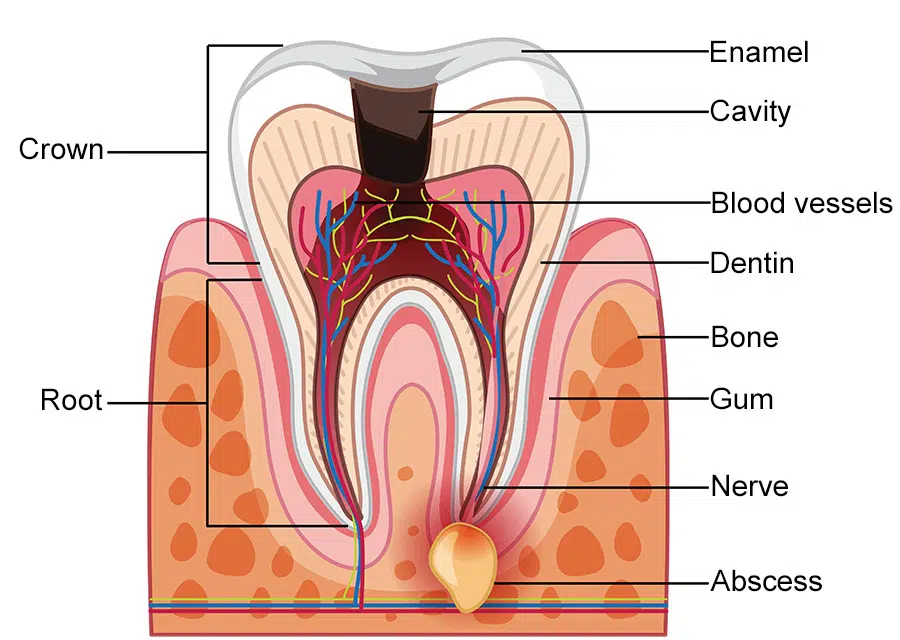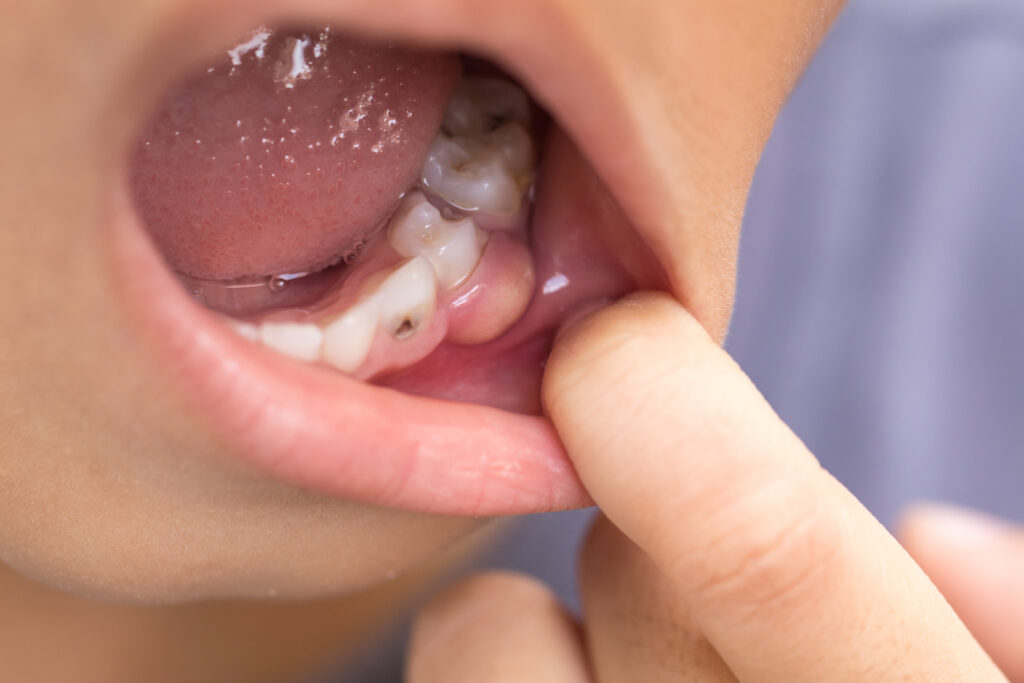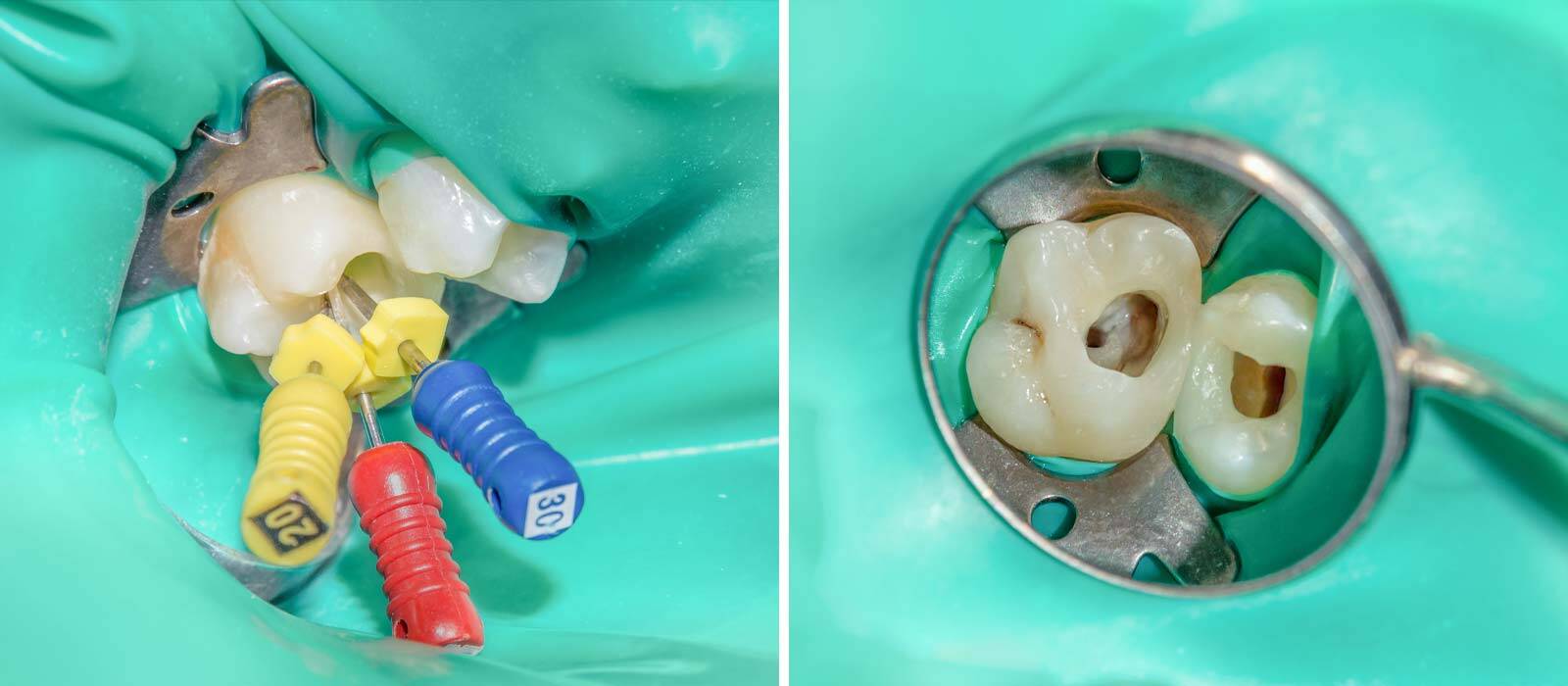 Gum and tooth abscesses can cause intense pain and discomfort, signalling an underlying infection that requires immediate attention. A dental abscess is a pocket of pus that forms within the gums or tooth roots, often due to bacterial infection.
Gum and tooth abscesses can cause intense pain and discomfort, signalling an underlying infection that requires immediate attention. A dental abscess is a pocket of pus that forms within the gums or tooth roots, often due to bacterial infection.
Understanding the causes, symptoms, and available treatment options for gum and tooth abscesses is essential for finding relief and preventing further complications.
At Amazing Smiles, our experienced dental professionals are dedicated to addressing your concerns and restoring your oral health. If you’re experiencing the discomfort and pain of a gum or tooth abscess, our dentists can help provide the relief you need.
From gentle and thorough examinations to advanced treatment options, we are committed to providing you with the highest quality care. Don’t let the abscess worsen or cause further complications. Contact Amazing Smiles today to schedule your consultation and take the first step towards a healthier, pain-free smile.
 Dental Abscess Causes and Symptoms
Dental Abscess Causes and Symptoms
Gum and tooth abscesses can develop due to various factors, including untreated dental decay, gum disease, dental trauma, or failed dental procedures.
The most common symptoms of an abscess include severe and throbbing toothache, swelling of the face or gums, tender and swollen lymph nodes, fever, and a pimple-like bump on the gums or near the affected tooth. If you experience any of these symptoms, it is crucial to seek prompt dental care.
Professional Diagnosis
When you visit your local dentist at Amazing Smiles with symptoms suggestive of a gum or tooth abscess, they will thoroughly examine your oral cavity.
This may involve visually inspecting the affected area, taking dental X-rays to evaluate the extent of the infection, and conducting specific tests to identify the underlying cause.
Proper diagnosis is crucial in determining the appropriate course of treatment and is usually performed under a standard check-up examination consultation.
Tooth Abscess
A tooth abscess is a localized infection that forms in the tooth root or the space between the tooth and gum.
It occurs when bacteria invade the tooth, often as a result of tooth decay, untreated dental cavities, or a cracked tooth.
The infection leads to the accumulation of pus, causing swelling, severe tooth pain, and sometimes the development of a visible pimple-like bump on the gum near the affected tooth.
Tooth abscesses require immediate dental attention to relieve pain, treat the infection, and prevent further complications.
Gum Abscess
A gum abscess, also known as a periodontal abscess, is a localized infection that occurs in the gum tissue. It is usually caused by bacteria entering the space between the tooth and gum, leading to swelling, pain, and the formation of pus.
Gum abscesses are often associated with gum disease and can result from untreated gum infections or complications of deep gum pockets.
Prompt dental treatment is necessary to alleviate symptoms, eliminate the infection, and prevent further complications.

Causes & Dental Treatment Options for an Abscess
We're here to help treat your dental abscess
Treating gum and tooth abscesses aims to eliminate the infection, alleviate pain, and preserve the affected tooth and surrounding oral structures. The specific treatments may vary based on the severity of the abscess and the extent of the infection. Standard treatment methods include:
Antibiotics
If the infection has spread beyond the abscess site or you have a weakened immune system, your dentist might prescribe antibiotics to help clear the infection.
However, antibiotics alone are not a cure for a dental abscess; they can be used with other treatments.
Incision and Drainage
For a dental abscess that has formed a pus-filled pocket, a dentist may need to make a small cut to drain the pus, which can provide immediate relief from pain and pressure.
Root Canal Treatment
A root canal procedure may be necessary if the abscess originates from an infected tooth nerve (pulp). This involves removing the infected tissue, cleaning the root canals, and sealing them to prevent reinfection.
As a result, root canal therapy can save the tooth from extraction.
Gum Treatment
If the abscess is caused by gum disease, the dentist may perform deep cleaning procedures, such as scaling and root planing, to remove plaque and bacteria from the gums.
In more severe cases, surgical intervention may be required to eliminate the infection and restore gum health.
Tooth Extraction
When a tooth is severely damaged or cannot be saved, the dentist may recommend extracting it to prevent the spread of infection to nearby teeth and tissues.
After extraction, suitable tooth replacement options can be discussed.
Specialist Periodontist Referral
Dentists may refer patients to periodontists (gum specialists) for expert treatment when diagnosing a severe case. If an abscess has spread to the surrounding bone, surgical intervention might be required to remove the infected tissue and possibly treat the bone.
Following dental treatment for a gum or tooth abscess, it is essential to maintain good oral hygiene practices and adhere to any prescribed medications or follow-up appointments.
Regular dental check-ups and cleans and preventive measures such as brushing and flossing can help prevent future abscesses and maintain optimal oral health.
Treating infected pulp
At Amazing Smiles, our dental team is skilled in performing these procedures with precision and care.
By removing the infected pulp, cleaning the canals, and sealing the tooth, we can save your natural tooth.
Contact us today to schedule a consultation and take the first step towards a pain-free, healthy smile.
Gum abscess treatment
At Amazing Smiles, our skilled dental team provides comprehensive gum treatments to address gum disease, which is often the underlying cause of abscess formation.
By removing plaque buildup, scaling and root planing and personalised care, we can help alleviate pain, reduce inflammation, and prevent further complications.
Don’t let a dental abscess affect your oral health. Contact us today to schedule a consultation and discover the benefits of our exceptional gum treatment services.
For severe cases of gum infection, patients may be referred to a Periodontists (gum specialists) for treatment.
Removing a tooth with an abscess
At Amazing Smiles, our experienced dental team performs gentle and cost-effective tooth removal procedures to eliminate the source of infection and alleviate pain.
However, it’s important to note that tooth removal may have negative implications, such as changes in bite alignment or difficulty chewing.
We recommend exploring restorative options, such as dental implants or bridges, to replace the missing tooth and restore oral function.
If you’re experiencing a dental abscess, contact us today to schedule an appointment and explore the best treatment options for your oral health needs.
Yes, it is possible to have a tooth infection without requiring a root canal.
The need for a root canal treatment depends on various factors, including the extent of the infection, the location of the infection, and the overall condition of the tooth.
In some cases, a tooth infection can be treated with less invasive measures, such as a dental filling or a minor procedure to drain the infection.
However, if the infection has reached the tooth’s nerve or pulp, a root canal may be necessary to remove the infected tissue and save the tooth.
It is important to consult with your dentist to determine the appropriate treatment for your specific situation.
They will evaluate the infection and recommend the most suitable course of action to alleviate the infection, relieve pain, and preserve your dental health.
Whether or not an abscessed tooth needs to be removed really depends on a few key factors. These include how serious the infection is, the condition of the tooth, and your overall oral health. An abscess is more than just a toothache, it’s a serious infection that can spread to other parts of your body if left untreated. That’s why it’s so important to see a dentist or endodontist for a proper evaluation.
In some cases, if the abscess is severe and the tooth is too damaged to fix, your dentist may recommend pulling it out. This is usually the last resort if the tooth can’t be saved with a root canal or other treatment.
Often, though, a dentist will first try to save the tooth. They might prescribe antibiotics to reduce the infection, followed by a root canal to clean out the infected area and seal the tooth. If this works, there’s a good chance the tooth can stay right where it is.
The decision can also depend on the health of nearby teeth and gums. If the abscessed tooth is affecting your overall oral health, removing it might be the safer option.
For people with certain medical conditions or weakened immune systems, dentists might lean toward removing the tooth more quickly to stop the infection from spreading.
No, a dental abscess will not go away on its own.
In some cases, a tooth abscess may temporarily improve or appear to go away on its own.
This can happen if the body’s immune system successfully fights off the infection, or if the abscess ruptures and drains on its own.
However, it is important to note that even if the symptoms subside, the infection may still persist and can potentially return or worsen in the future.
It is strongly recommended to seek dental treatment for a tooth abscess as soon as possible.
A dentist can properly diagnose the abscess, address the underlying cause, and provide appropriate treatment to eliminate the infection and prevent further complications.
Delaying treatment can lead to the spread of infection, damage to surrounding teeth and tissues, and potential systemic health issues.
Start by gently rinsing your mouth with warm saltwater. This helps cleanse the area, flush out some of the bacteria, and can bring a bit of relief. Let the fluid drain naturally. It’s advisable to spit this fluid out, don’t swallow it, as it contains harmful bacteria.
Keep the area as clean as possible. Continue brushing your teeth gently, especially around the affected area, to help prevent further infection. If your cheek is swollen or sore, applying a cold compress on the outside of your face can reduce swelling and ease the discomfort.
Most importantly, contact your nearest dentist. Even if the pain has eased, the infection hasn’t fully gone away and still needs professional treatment. Your dentist will examine the area, clean the infection properly, and may prescribe antibiotics or perform a procedure like a root canal to treat the root cause.
Getting prompt dental care is essential to stop the infection from spreading.
After a tooth extraction, the abscess that was present in the affected tooth usually begins to heal.
The removal of the tooth eliminates the source of infection, allowing the body’s natural healing process to take place.
As the extraction site heals, the body works to close the gap and form a blood clot, which protects the area and promotes tissue regeneration.
Over time, the abscess should subside, and any associated symptoms, such as pain and swelling, should gradually improve.
However, it’s essential to follow post-operative instructions provided by your dentist to ensure proper healing and minimize the risk of complications.
If you have any concerns or questions following a tooth extraction and the resolution of an abscess, it’s always best to consult with your dentist for further guidance.
A tooth infection and a tooth abscess are related conditions but have some differences.
A tooth infection generally refers to a bacterial infection within the tooth itself, often caused by deep decay or a cracked tooth. It can cause pain, sensitivity, and swelling around the affected tooth.
On the other hand, a tooth abscess is a more severe form of infection that occurs when the infection spreads to the surrounding tissues, forming a pocket of pus.
It can cause intense pain, swelling, fever, and a pimple-like bump on the gum.
While both conditions require prompt dental treatment, a tooth abscess typically indicates a more advanced stage of infection and may require more aggressive intervention, such as a root canal or tooth extraction.
It’s important to consult with a dentist to determine the best course of action for your specific situation.
No, gum abscess and tooth abscess are not the same thing, although they can be related.
A gum abscess, also known as a periodontal abscess, is an infection that occurs in the gum tissue.
It is usually caused by bacteria entering the space between the tooth and gum, leading to localized swelling, pain, and the formation of pus.
Gum abscesses are often associated with gum disease and can occur as a result of an untreated gum infection or as a complication of a deep gum pocket.
On the other hand, a tooth abscess, also called a periapical abscess, is an infection that occurs within the tooth itself. It typically develops as a result of untreated tooth decay or a dental injury that allows bacteria to reach the dental pulp, which is the soft tissue inside the tooth.
The infection then spreads to the root of the tooth, leading to pain, swelling, and the formation of an abscess at the root tip.
While gum and tooth abscesses can have similar symptoms, such as pain and swelling, they involve different areas and structures. Gum abscesses primarily affect the gum tissue, while tooth abscesses are specific to the tooth and its root.
Both gum and tooth abscesses require prompt dental treatment to alleviate pain, eliminate the infection, and prevent further complications.
If you suspect you have an abscess, it’s important to consult with a dentist who can provide a proper diagnosis and recommend the appropriate treatment.
If a tooth abscess is left untreated, it can lead to several potential complications. The infection can spread to the surrounding tissues, including the jawbone and nearby teeth, causing a more severe infection. The abscess can also cause significant pain and discomfort.
Without treatment, the infection may persist and worsen over time, leading to the destruction of the tooth’s supporting structures, including the bone and ligaments.
In some cases, the infection can even spread to other parts of the body, resulting in serious health complications. It is crucial to seek dental care promptly to prevent these complications and ensure the proper treatment of a tooth abscess.
If a gum abscess is left untreated, it can lead to several potential complications.
The infection can spread to surrounding tissues and bones, causing a more severe oral infection.
It may result in the loss of bone supporting the teeth, leading to tooth mobility or even tooth loss.
The abscess can also rupture, releasing the pus into the mouth, but this doesn’t mean the infection is resolved.
Without proper treatment, the abscess is likely to reoccur. Additionally, untreated gum abscesses can contribute to the progression of gum disease, leading to further oral health issues.
It is essential to seek dental care promptly to prevent these complications and ensure the proper treatment of a gum abscess.
We accept all major health funds

